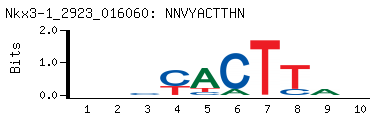|
|
| -Genomic Data |
Links |
- Protein
- Nkx3-1
|
- UniPROBE Accession Number
- UP00017
|
- Species
- Mus musculus
|
- Domain
- Homeobox
|
- Uniprot
-
P97436
|
- Name and Synonyms
-
NK-3 transcription factor, locus 1 (Drosophila)
bagpipe, Bax, Homeobox protein Nkx-3.1, NKX3.1, Nkx-3.1, Nkx3a, NKX3A
|
- IHOP
-
123148
|
- RefSeq
-
NP_035051
|
- Description
- Mus musculus homeobox-containing protein Nkx-3.1 mRNA
|
- JASPAR
-
None Available
|
| -PBM Motif Data for Nkx3-1 |
- Primary Motif (Seed-And-Wobble)
-

|
- Primary PWM
-
View
Save
|
- Top Kmer
-
CCACTTAA E.S. 0.498
TTAAGTGG E.S. 0.498
|
- Secondary Motif (Seed-And-Wobble)
-

|
- Secondary PWM
-
View
Save
|
- Top Kmer
-
AAGTACTT E.S. 0.496
AAGTACTT E.S. 0.496
|
-
Motif (BEEML-PBM) (AMADID # 015681)
(clone pTH2923)
-

|
- PWM
-
View
|
- Consensus
-
NNVYACTTNN
NNAAGTRBNN
|
-
Motif (BEEML-PBM) (AMADID # 016060) (clone pTH2923)
-

|
- PWM
-
View
|
- Consensus
-
NNVYACTTHN
NDAAGTRBNN
|
- Downloads
-
Download the
zip
of all Nkx3-1 PBM files
or view the
downloads directory
for individual files.
|
- Link to TFBSshape
-
This link will take you to the corresponding entry for Nkx3-1
in TFBSshape,
a database which provides information about the shape of the DNA at transcription factor binding sites.
http://rohslab.cmb.usc.edu/TFBSshape/?tfid=&geneID=17&sourceDB=uniprobe
|
| -Nkx3-1 Datasets |
| Clone ID |
Expression |
Array Version |
Expression Protocol |
Clone Type |
Last Modified |
Save |
View |
|
pTH2923 |
#1 |
AMADID #016060 |
E. coli |
DNA binding domain only |
2014-08-22 |

|

|
| Clone ID |
Expression |
Array Version |
Expression Protocol |
Clone Type |
Last Modified |
Save |
View |
|
pTH2923 |
#1 |
AMADID #015681 |
E. coli |
DNA binding domain only |
2014-08-22 |

|

|
- Clone pTH2923 insert sequence
- 1 NPGDLASAPQ VTKQPQKRSR AAFSHTQVIE LERKFSHQKY LSAPERAHLA
51 KNLKLTETQV KIWFQNRRYK TKRKQLSEDL GVLEKNSPLS LPA
- DNA Binding Domains (Pfam) for clone 2923
-
Region 17..73
1 KRSRAAFSHT QVIELERKFS HQKYLSAPER AHLAKNLKLT ETQVKIWFQN
51 RRYKTKR
-
|
- References
-
Data are analyzed by array designs with AMADID #s 016060, 015681 in Badis et al., Science 2009
|
|